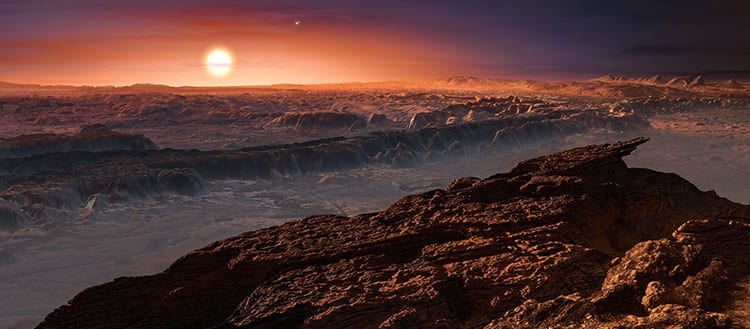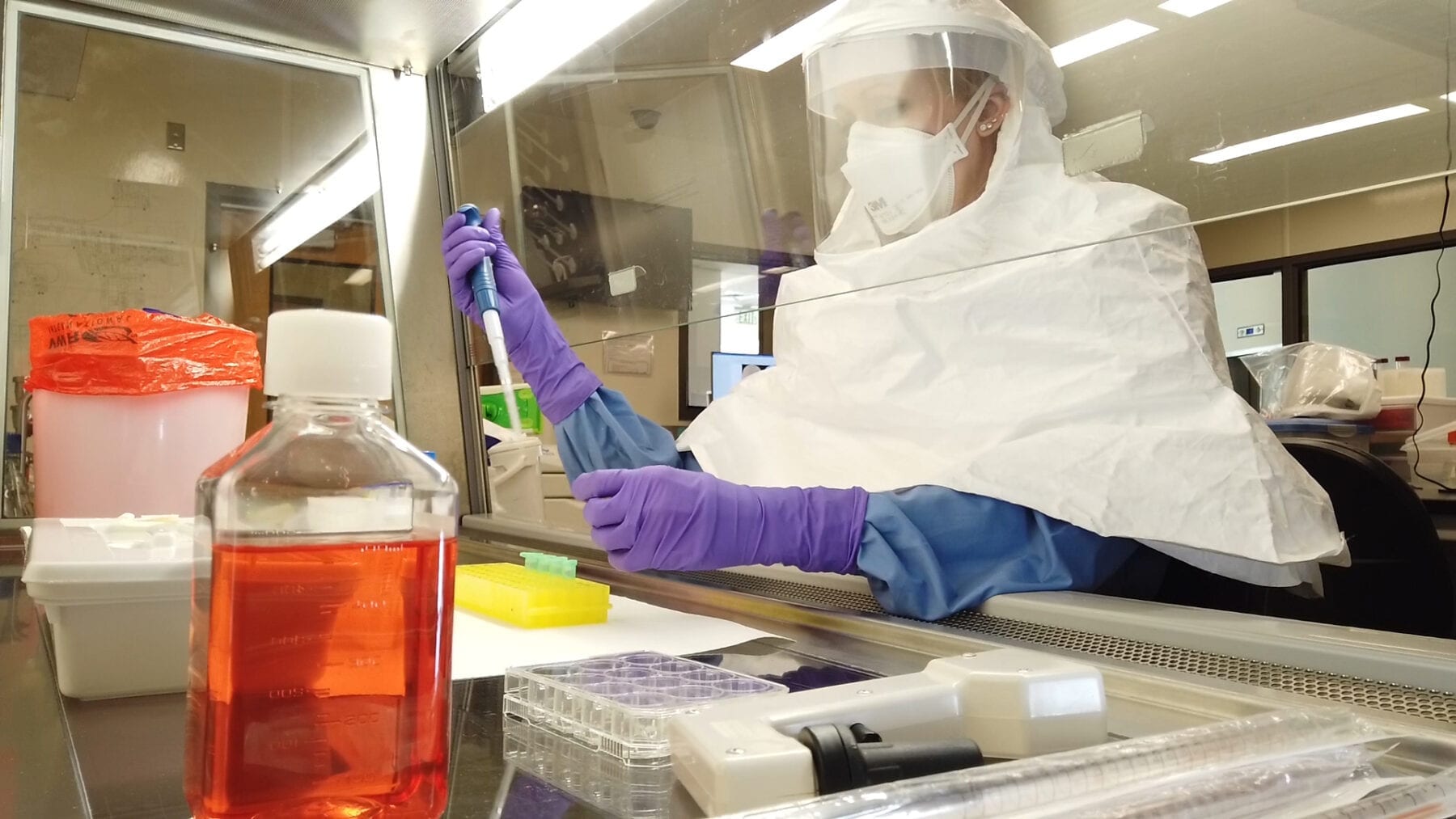
This artist’s impression shows a view of the surface of the planet Proxima b orbiting the red dwarf star Proxima Centauri, the closest star to the Solar System. via ESO/M. Kornmesser
Researchers from the University of Geneva, have confirmed the existence of the Proxima b extrasolar planet using measurements from the Swiss-built ESPRESSO spectrograph.
The existence of a planet the size of Earth around the closest star in the solar system, Proxima Centauri, has been confirmed by an international team of scientists including researchers from the University of Geneva (UNIGE). The results, which you can read all about in the journal Astronomy & Astrophysics, reveal that the planet in question, Proxima b, has a mass of 1.17 earth masses and is located in the habitable zone of its star, which it orbits in 11.2 days.
This breakthrough has been possible thanks to radial velocity measurements of unprecedented precision using ESPRESSO, the Swiss-manufactured spectrograph – the most accurate currently in operation – which is installed on the Very Large Telescope in Chile. Proxima b was first detected four years ago by means of an older spectrograph, HARPS – also developed by the Geneva-based team – which measured a low disturbance in the star’s speed, suggesting the presence of a companion.
The ESPRESSO spectrograph has performed radial velocity measurements on the star Proxima Centauri, which is only 4.2 light-years from the Sun, with an accuracy of 30 centimetres a second (cm/s) or about three times more precise than that obtained with HARPS, the same type of instrument but from the previous generation.
“We were already very happy with the performance of HARPS, which has been responsible for discovering hundreds of exoplanets over the last 17 years”, begins Francesco Pepe, a professor in the Astronomy Department in UNIGE’s Faculty of Science and the man in charge of ESPRESSO. “We’re really pleased that ESPRESSO can produce even better measurements, and it’s gratifying and just reward for the teamwork lasting nearly 10 years.”
Alejandro Suarez Mascareño, the article’s main author, adds: “Confirming the existence of Proxima b was an important task, and it’s one of the most interesting planets known in the solar neighbourhood.”
The measurements performed by ESPRESSO have clarified that the minimum mass of Proxima b is 1.17 earth masses (the previous estimate was 1.3) and that it orbits around its star in only 11.2 days.
“ESPRESSO has made it possible to measure the mass of the planet with a precision of over one-tenth of the mass of Earth”, says Michel Mayor, winner of the Nobel Prize for Physics in 2019, honorary professor in the Faculty of Science and the ‘architect’ of all ESPRESSO-type instruments. “It’s completely unheard of.”
And what about life in all this?
Although Proxima b is about 20 times closer to its star than the Earth is to the Sun, it receives comparable energy, so that its surface temperature could mean that water (if there is any) is in liquid form in places and might, therefore, harbour life.
Having said that, although Proxima b is an ideal candidate for biomarker research, there is still a long way to go before we can suggest that life has been able to develop on its surface. In fact, the Proxima star is an active red dwarf that bombards its planet with X rays, receiving about 400 times more than the Earth.
“Is there an atmosphere that protects the planet from these deadly rays?” asks Christophe Lovis, a researcher in UNIGE’s Astronomy Department and responsible for ESPRESSO’s scientific performance and data processing. “And if this atmosphere exists, does it contain the chemical elements that promote the development of life (oxygen, for example)? How long have these favourable conditions existed? We’re going to tackle all these questions, especially with the help of future instruments like the RISTRETTO spectrometer, which we’re going to build specially to detect the light emitted by Proxima b, and HIRES, which will be installed on the future ELT 39 m giant telescope that the European Southern Observatory (ESO) is building in Chile.”
Surprise: is there a second planet?
In the meantime, the precision of the measurements made by ESPRESSO could result in another surprise. The team has found evidence of a second signal in the data, without being able to establish the definitive cause behind it. “If the signal was planetary in origin, this potential other planet accompanying Proxima b would have a mass less than one third of the mass of the Earth. It would then be the smallest planet ever measured using the radial velocity method”, adds Professor Pepe.
It should be noted that ESPRESSO, which became operational in 2017, is in its infancy and these initial results are already opening up undreamt of opportunities. The road has been travelled at breakneck pace since the first extrasolar planet was discovered by Michel Mayor and Didier Queloz, both from UNIGE’s Astronomy Department. In 1995, the 51Peg b gas giant planet was detected using the ELODIE spectrograph with an accuracy of 10 meters per second (m/s). Today ESPRESSO, with its 30 cm/s (and soon 10 after the latest adjustments) will perhaps make it possible to explore worlds that remind us of the Earth.
The Latest Updates from Bing News & Google News
Go deeper with Bing News on:
Proxima b extrasolar planet
- Will we know if TRAPPIST-1e has life?
The search for extrasolar planets is currently undergoing a seismic shift. With the deployment of the Kepler Space Telescope and the Transiting Exoplanet Survey Satellite (TESS), scientists discovered ...
- Extrasolar Planets News
Unlocking the Secrets of a 'Hot Saturn' and Its Spotted Star Jan. 9, 2024 — A team of astronomers has unraveled the enigmatic atmosphere of the exoplanet HAT-P-18 b, shedding light on its ...
- What could the Extremely Large Telescope see at Proxima Centauri's planet?
Our usual methods for detecting biosignatures won't work with Proxima Centauri B. Most exoplanets are discovered through the transit method, where a planet regularly passes in front of its star ...
- Extrasolar Planets and Planetary Systems
Extrasolar planets contextualise the Solar System among a large number of planetary systems with very different properties. Many extrasolar planets show characteristics which are not realised in the ...
- Invaders from Proxima B
wise-cracking alien from Proxima B named Chuck crash lands in their backyard, the Jankins family must work together to save their new fuzzy friend from a dangerous array of weirdos that show up in ...
Go deeper with Google Headlines on:
Proxima b extrasolar planet
[google_news title=”” keyword=”Proxima b extrasolar planet” num_posts=”5″ blurb_length=”0″ show_thumb=”left”]
Go deeper with Bing News on:
Planet in the habitable zone
- ‘We live in a golden time of exploration’: astronomer Lisa Kaltenegger on the hunt for signs of extraterrestrial life
Astronomer Lisa Kaltenegger has spent her life hunting for signs of life in the universe. Here she tells Emma Beddington about aliens, space exploration and why studying cosmology is like eating pizza ...
- Distant planet twice the size of Earth may be emitting gas 'only produced by life'
Scientists might have just stumbled upon evidence of life on a distant planet, K2-18b, which is twice the size of Earth and seems to be emitting gas typically "only produced by life". The celestial ...
- Forget green: Purple may be key to finding planets capable of hosting alien life, study says
Purple bacteria that thrive in low-energy red or infrared light with a simpler method of photosynthesis could cover another planet, a new study says.
- Life Under Three Suns: The Real Physics Behind Netflix’s 3 Body Problem
How would the chaotic alien world from the series' virtual reality game look in real life? We spoke to the show's science advisor to find out.
- How could life survive on tidally locked planets?
Astronomers are especially interested in the habitability of these kinds of planets, which always face their star with the same side, because they are incredibly common in the universe.
Go deeper with Google Headlines on:
Planet in the habitable zone
[google_news title=”” keyword=”planet in the habitable zone” num_posts=”5″ blurb_length=”0″ show_thumb=”left”]










